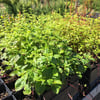Mentha australis - Native River Mint
Mentha australis - Native River Mint
Habit and Habitat:
Mentha australis, commonly known as Native River Mint, thrives in damp and riparian environments, such as riverbanks and wetlands, making it a refreshing addition to any garden near water sources.
IUCN Conservation Status:
As of the latest assessment, Mentha australis is not listed on the IUCN Red List, indicating that it currently faces no significant conservation threats. This versatile species contributes to the ecological diversity of its natural habitat.
Place in Local Habitat and Ecosystem Distribution:
Native River Mint plays a vital role in various Australian water-side habitats, including riverbanks, streams, and wetlands. Its presence enhances the biodiversity of these environments and supports a variety of aquatic life.
Planting Companions:
In your garden, Native River Mint can be companion-planted with other water-loving native species such as Carex spp., Juncus spp., and Persicaria species. Together, they create a lush and vibrant waterside garden.
Human and Wildlife Uses:
Mentha australis holds cultural significance in Indigenous Australian traditions, where its aromatic leaves were used for medicinal and culinary purposes. In modern gardens, it serves as a delightful culinary herb for humans and provides a habitat and food source for aquatic insects and other wildlife.
Care Instructions:
To successfully grow Native River Mint in your garden, choose a location with consistently moist soil and partial shade, mimicking its natural riparian habitat. Regular watering and occasional pruning will help maintain its vigor and flavor.
Size, Height, Width, Flower, and Leaf Characteristics:
Native River Mint is a spreading herbaceous plant, typically reaching heights of 30 to 60 centimeters. Its oval leaves are a rich green with a delightful minty aroma when crushed. Tiny white to lilac flowers cluster at the tips of the stems during the flowering season.
Latin Etymology:
The genus name "Mentha" traces back to the Greek myth of Minthe, who was transformed into a mint plant by the goddess Persephone. The species name "australis" refers to its southern Australian origin.
Traditional Uses:
Native River Mint has a history of traditional uses by Indigenous Australian communities, who valued its leaves for medicinal teas and as a flavoring agent in foods. It was also used to make aromatic oils and poultices.

